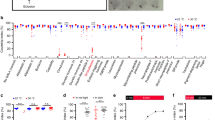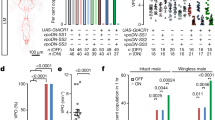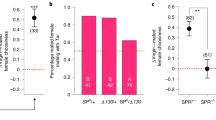Abstract
Mate choice is an evolutionarily critical decision that requires the detection of multiple sex-specific signals followed by central integration of these signals to direct appropriate behavior. The mechanisms controlling mate choice remain poorly understood. Here, we show that the glial amino-acid transporter genderblind controls whether Drosophila melanogaster males will attempt to mate with other males. Genderblind (gb) mutant males showed no alteration in heterosexual courtship or copulation, but were attracted to normally unappealing male species-specific chemosensory cues. As a result, genderblind mutant males courted and attempted to copulate with other Drosophila males. This homosexual behavior could be induced within hours using inducible RNAi, suggesting that genderblind controls nervous system function rather than its development. Consistent with this, and indicating that glial genderblind regulates ambient extracellular glutamate to suppress glutamatergic synapse strength in vivo, homosexual behavior could be turned on and off by altering glutamatergic transmission pharmacologically and/or genetically.
This is a preview of subscription content, access via your institution
Access options
Subscribe to this journal
Receive 12 print issues and online access
$209.00 per year
only $17.42 per issue
Buy this article
- Purchase on Springer Link
- Instant access to full article PDF
Prices may be subject to local taxes which are calculated during checkout




Similar content being viewed by others
Change history
16 December 2007
In the version of this article originally published online, the title was incorrect. The correct title is "A glial amino-acid transporter controls synapse strength and courtship in Drosophila." This error has been corrected for all versions of the article.
11 January 2008
In the version of this article originally published online, the titles and captions of supplementary videos were missing. The error has been corrected online.
References
Spieth, H.T. Courtship behavior in Drosophila. Annu. Rev. Entomol. 19, 385–405 (1974).
Greenspan, R.J. & Ferveur, J.F. Courtship in Drosophila. Annu. Rev. Genet. 34, 205–232 (2000).
Billeter, J.C., Rideout, E.J., Dornan, A.J. & Goodwin, S.F. Control of male sexual behavior in Drosophila by the sex determination pathway. Curr. Biol. 16, R766–R776 (2006).
Shirangi, T.R. & McKeown, M. Sex in flies: what 'body-mind' dichotomy? Dev. Biol. 306, 10–19 (2007).
van der Goes van Naters, W. & Carlson, J.R. Receptors and neurons for fly odors in Drosophila. Curr. Biol. 17, 606–612 (2007).
Lacaille, F. et al. An inhibitory sex pheromone tastes bitter for Drosophila males. PLoS ONE 2, e661 (2007).
Marcillac, F., Grosjean, Y. & Ferveur, J.F. A single mutation alters production and discrimination of Drosophila sex pheromones. Proc. Biol. Sci. 272, 303–309 (2005).
Ejima, A. et al. Generalization of courtship learning in Drosophila is mediated by cis-vaccenyl acetate. Curr. Biol. 17, 599–605 (2007).
Augustin, H., Grosjean, Y., Chen, K., Sheng, Q. & Featherstone, D.E. Nonvesicular release of glutamate by glial xCT transporters suppresses glutamate receptor clustering in vivo. J. Neurosci. 27, 111–123 (2007).
Featherstone, D.E. & Shippy, S.A. Regulation of synaptic transmission by ambient extracellular glutamate. Neuroscientist. published online 18 October 2007 (doi:10.1177/1073858407308518).
Kurtovic, A., Widmer, A. & Dickson, B.J. A single class of olfactory neurons mediates behavioural responses to a Drosophila sex pheromone. Nature 446, 542–546 (2007).
Jefferis, G.S. et al. Comprehensive maps of Drosophila higher olfactory centers: spatially segregated fruit and pheromone representation. Cell 128, 1187–1203 (2007).
Winther, A.M., Acebes, A. & Ferrus, A. Tachykinin-related peptides modulate odor perception and locomotor activity in Drosophila. Mol. Cell. Neurosci. 31, 399–406 (2006).
Rajewsky, N. MicroRNA target predictions in animals. Nat. Genet. 38 Suppl, S8–S13 (2006).
Dietzl, G. et al. A genome-wide transgenic RNAi library for conditional gene inactivation in Drosophila. Nature 448, 151–156 (2007).
Daniels, R.W. et al. Increased expression of the Drosophila vesicular glutamate transporter leads to excess glutamate release and a compensatory decrease in quantal content. J. Neurosci. 24, 10466–10474 (2004).
Bogdanik, L. et al. The Drosophila metabotropic glutamate receptor DmGluRA regulates activity-dependent synaptic facilitation and fine synaptic morphology. J. Neurosci. 24, 9105–9116 (2004).
Zhang, S.D. & Odenwald, W.F. Misexpression of the white (w) gene triggers male-male courtship in Drosophila. Proc. Natl. Acad. Sci. USA 92, 5525–5529 (1995).
Hing, A.L. & Carlson, J.R. Male-male courtship behavior induced by ectopic expression of the Drosophila white gene: role of sensory function and age. J. Neurobiol. 30, 454–464 (1996).
An, X., Armstrong, J.D., Kaiser, K. & O'Dell, K.M. The effects of ectopic white and transformer expression on Drosophila courtship behavior. J. Neurogenet. 14, 227–243, 271 (2000).
Svetec, N., Houot, B. & Ferveur, J.F. Effect of genes, social experience, and their interaction on the courtship behaviour of transgenic Drosophila males. Genet. Res. 85, 183–193 (2005).
Mahr, A. & Aberle, H. The expression pattern of the Drosophila vesicular glutamate transporter: a marker protein for motoneurons and glutamatergic centers in the brain. Gene Expr. Patterns 6, 299–309 (2006).
Schuster, C.M., Ultsch, A., Schmitt, B. & Betz, H. Molecular analysis of Drosophila glutamate receptors. EXS 63, 234–240 (1993).
Tomancak, P. et al. Systematic determination of patterns of gene expression during Drosophila embryogenesis. Genome Biol. [online] 3, RESEARCH0088 (2002) (doi:10.1186/gb-2002-3-12-research0088).
Featherstone, D.E. et al. An essential Drosophila glutamate receptor subunit that functions in both central neuropil and neuromuscular junction. J. Neurosci. 25, 3199–3208 (2005).
Xia, S. et al. NMDA receptors mediate olfactory learning and memory in Drosophila. Curr. Biol. 15, 603–615 (2005).
Sato, H., Tamba, M., Ishii, T. & Bannai, S. Cloning and expression of a plasma membrane cystine/glutamate exchange transporter composed of two distinct proteins. J. Biol. Chem. 274, 11455–11458 (1999).
Baker, D.A., Xi, Z.X., Shen, H., Swanson, C.J. & Kalivas, P.W. The origin and neuronal function of in vivo nonsynaptic glutamate. J. Neurosci. 22, 9134–9141 (2002).
Piyankarage, S.C., Augustin, H., Featherstone, D.E. & Shippy, S.A. Amino acid analysis of hemolymph from individual Drosophila melanogaster. Anal. Chem. (in the press) (2008).
Juhasz, G. et al. Sleep promoting effect of a putative glial gamma-aminobutyric acid uptake blocker applied in the thalamus of cats. Eur. J. Pharmacol. 209, 131–133 (1991).
Lena, I. et al. Variations in extracellular levels of dopamine, noradrenaline, glutamate and aspartate across the sleep-wake cycle in the medial prefrontal cortex and nucleus accumbens of freely moving rats. J. Neurosci. Res. 81, 891–899 (2005).
Castaneda, T.R., de Prado, B.M., Prieto, D. & Mora, F. Circadian rhythms of dopamine, glutamate and GABA in the striatum and nucleus accumbens of the awake rat: modulation by light. J. Pineal Res. 36, 177–185 (2004).
Lee, Y., Gaskins, D., Anand, A. & Shekhar, A. Glia mechanisms in mood regulation: a novel model of mood disorders. Psychopharmacology (Berl.) 191, 55–65 (2007).
Adachi, A., Natesan, A.K., Whitfield-Rucker, M.G., Weigum, S.E. & Cassone, V.M. Functional melatonin receptors and metabolic coupling in cultured chick astrocytes. Glia 39, 268–278 (2002).
Baker, D.A. et al. Contribution of cystine-glutamate antiporters to the psychotomimetic effects of phencyclidine. Neuropsychopharmacology. advance online publication 29 August 2007 (doi:10.1038/sj.npp.1301532).
Baker, D.A. et al. Neuroadaptations in cystine-glutamate exchange underlie cocaine relapse. Nat. Neurosci. 6, 743–749 (2003).
Lim, J., Lam, Y.C., Kistler, J. & Donaldson, P.J. Molecular characterization of the cystine/glutamate exchanger and the excitatory amino acid transporters in the rat lens. Invest. Ophthalmol. Vis. Sci. 46, 2869–2877 (2005).
Burdo, J., Dargusch, R. & Schubert, D. Distribution of the cystine/glutamate antiporter system xc– in the brain, kidney and duodenum. J. Histochem. Cytochem. 54, 549–557 (2006).
Shih, A.Y. et al. Cystine/glutamate exchange modulates glutathione supply for neuroprotection from oxidative stress and cell proliferation. J. Neurosci. 26, 10514–10523 (2006).
Kimchi, T., Xu, J. & Dulac, C. A functional circuit underlying male sexual behaviour in the female mouse brain. Nature 448, 1009–1014 (2007).
Marcillac, F., Bousquet, F., Alabouvette, J., Savarit, F. & Ferveur, J.F. A mutation with major effects on Drosophila melanogaster sex pheromones. Genetics 171, 1617–1628 (2005).
Balakireva, M., Stocker, R.F., Gendre, N. & Ferveur, J.F. Voila, a new Drosophila courtship variant that affects the nervous system: behavioral, neural and genetic characterization. J. Neurosci. 18, 4335–4343 (1998).
Grosjean, Y., Balakireva, M., Dartevelle, L. & Ferveur, J.F. PGal4 excision reveals the pleiotropic effects of Voila, a Drosophila locus that affects development and courtship behaviour. Genet. Res. 77, 239–250 (2001).
Woodard, C., Huang, T., Sun, H., Helfand, S.L. & Carlson, J. Genetic analysis of olfactory behavior in Drosophila: a new screen yields the ota mutants. Genetics 123, 315–326 (1989).
Roberts, D.B. Drosophila: A Practical Approach 2nd edn (Oxford University Press, Oxford, 1998).
Horz, H.-P., Kurtz, R., Batey, D. & Bohannan, B. Monitoring microbial populations using real-time qPCR on the MJ research Opticon 2 system. MJ Research Application Note 3, 1–4 (2004).
Bellen, H.J. et al. The BDGP gene disruption project: single transposon insertions associated with 40% of Drosophila genes. Genetics 167, 761–781 (2004).
Zars, T., Fischer, M., Schulz, R. & Heisenberg, M. Localization of a short-term memory in Drosophila. Science 288, 672–675 (2000).
Masuda-Nakagawa, L.M., Tanaka, N.K. & O'Kane, C.J. Stereotypic and random patterns of connectivity in the larval mushroom body calyx of Drosophila. Proc. Natl. Acad. Sci. USA 102, 19027–19032 (2005).
Acknowledgements
We would like to thank P.-S. Ng for technical assistance, A. DiAntonio, T. Zars, R.F. Stocker, K. Broadie and H. for transgenic fly lines, W. Francke (University of Hamburg) for the synthesis of the 7-tricosene chemical, and B. Taylor (Oregon State) for helpful discussion and ideas. Other essential reagents were provided by the Drosophila Gene Disruption Project, the Vienna Drosophila RNAi Center and the Bloomington and Tucson Drosophila Stock Centers. Funding for this work was provided by grants from the Muscular Dystrophy Association and US National Institute of Neurological Disorders and Stroke (R01NS045628) to D.E.F., and by the Centre National de la Recherche Scientifique to J.-F.F.
Author information
Authors and Affiliations
Contributions
Y.G. made the original observation that gb mutant males courted each other and was responsible for all genetic and pharmacological manipulations, immunohistochemistry and most of the behavioral experiments and analysis. M.G. was responsible for some locomotory tests, the heterosexual copulation measurements and the desat mutant male experiments and contributed to decapitated partner courtship tests. H.A. was responsible for the gb real-time RT-PCR and GB immunoblot data. D.E.F, Y.G. and J-F.F. were responsible for experimental design and interpretation of results and writing the article.
Corresponding author
Supplementary information
Supplementary Text and Figures
Supplementary Figures 1–4 (PDF 1956 kb)
Supplementary Video 1
This video shows six wild-type (Oregon R) males. They display little courtship behavior. (WMV 3057 kb)
Supplementary Video 2
This video shows six gb[KG07905] mutant males. They display frequent and extensive homosexual courtship behavior. (WMV 3047 kb)
Supplementary Video 3
This video shows six precise excision males (flies where the gb[KG07095] transposon has been precisely excised). They display very little courtship behavior. (WMV 3056 kb)
Supplementary Video 4
This video shows six males of the genotype TubGal4/UAS-DVGluT. In these flies, the Drosophila vesicular glutamate transporter DVGluT has been overexpressed to increase glutamatergic synapse strength. These flies display frequent and extensive homosexual courtship behavior. (WMV 1825 kb)
Supplementary Video 5
This video shows six gb[KG07095] mutant males that have drunk apple juice containing gamma-D-glutamylglycine (gamma-DGG), a competitive glutamate receptor antagonist that weakens glutamatergic synapse strength. These display very little courtship behavior. (WMV 244 kb)
Rights and permissions
About this article
Cite this article
Grosjean, Y., Grillet, M., Augustin, H. et al. A glial amino-acid transporter controls synapse strength and courtship in Drosophila. Nat Neurosci 11, 54–61 (2008). https://doi.org/10.1038/nn2019
Received:
Accepted:
Published:
Issue Date:
DOI: https://doi.org/10.1038/nn2019
This article is cited by
-
A broader cultural view is necessary to study the evolution of sexual orientation
Nature Ecology & Evolution (2024)
-
Drosophila mutants lacking the glial neurotransmitter-modifying enzyme Ebony exhibit low neurotransmitter levels and altered behavior
Scientific Reports (2023)
-
Growth regulation by amino acid transporters in Drosophila larvae
Cellular and Molecular Life Sciences (2020)
-
The sulfite oxidase Shopper controls neuronal activity by regulating glutamate homeostasis in Drosophila ensheathing glia
Nature Communications (2018)
-
Amino acid transporters implicated in endocytosis of Buchnera during symbiont transmission in the pea aphid
EvoDevo (2016)



